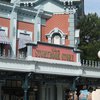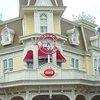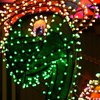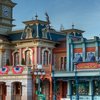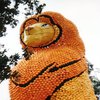Designing Main Street USA - Disney & Co Shop
The Disney & Co Shop is located on the west side of Main Street USA, Disneyland Park, Paris, between Casey’s Corner and Lilly’s Boutique. It sells Disney themed plush and toys. The shop is being themed to a turn-of-the-century traveling carnival or fairground.

In contrast to the other Main Street USA venues, the Disney & Co Shop does not try to replicate a historic interior but rather uses bygone themes and elements to create an environment that supports the sale of the merchandise being offered. After all, plush and toys were traditionally the prizes that you could’ve won at a fair.
The design and style of the shop was inspired by the images from the book ‘Fairground Art’ (by Geoff Weedon & Richard Ward) and the Disney movies ‘So Dear to my Heart’ and ‘Summer Magic’.

‘So dear to my Heart’ (1948) tells the story of a determined young country boy and his quest to raise a black lamb to become a premium animal at the Pike County Fair. The movie is based on the book ‘Midnight and Jeremiah’ written by Sterling North. Like ‘Song of the South’, it combines animation and live action.
‘Summer Magic’ is a 1963 feature film based on the book ‘Mother Carey's Chickens’ by Kate Douglas Wiggin. The story is about a widow and her children taking up residence in a small town in Maine, USA.

As guests enter the front door of the Disney & Co Store, stunningly decorated with ‘American Stained Glass’, they will immediately notice the huge hot air balloon holding three Disney characters.
The interesting display has been installed by request of the Merchandise Department to lure shoppers into the store. It is the perfect match for the overall theme since Victorian fairs often offered balloon rides.

The interior of the Disney & Co Store is reminiscent of the ‘Greek Revival’. This architectural style was typical of the time and works well with the Americana theme.
The ‘Greek Revival’ dominated American architecture in the late 18th and early 19th centuries. It is often considered the first national architectural style in the United States, found in all regions of the country. Inspired by the architecture of ancient Greece, buildings in this style are patterned after Greek temples.

The style arose out of a young nation's desire to identify with the ideals of the ancient Greek Republic. At the same time, the War of 1812 diminished American affection for British architecture.
Decorations inspired by the Flag of the United States of America, such as festooning and bunting, were used throughout the shop. This perfectly fits the American patriotism that was so prevalent in turn-of-the-century small town celebrations.

Historical light fixtures and colorful billboards line the walls. All billboards refer to the products on sale or exhibits featuring curiosities that could be found at many traveling carnivals (‘See Electric Wonders’ introducing electricity).

Carousels made by the Philadelphia Toboggan Company inspired the design of the circular area in the center of the Disney & Co Store.

The Philadelphia Toboggan Company (‘PTC’) is the oldest existing roller coaster manufacturing company in the world. Based in Hatfield, Pennsylvania, it was established in 1904 by Henry B. Auchy and Chester Albright, making various amusement devices, including carousels (until 1934), wooden roller coasters, and their trains.


The company's carousels were known for their elaborate carvings and elegant decorations. The PTC carousel horses are part of the Philadelphia style of carousel horses.

Philadelphia-style horses are carved to be more realistic than the fanciful Coney Island-style carousel horses, but more elaborate than the simpler Country Fair style. PTC carousel horses were known for their sweet features and detailed armor.

Most of the PTC carousels have been numbered, so they could be easily identified. F.e. number 46 was built in 1917 for the Detroit Palace Garden Park. Nowadays, it is known by the name ‘Prince Charming Regal Carousel’ and located at Fantasyland, Walt Disney World.
Beautiful ‘rounding boards’ can be found above the shopping shelves of the Disney & Co Store.


Rounding boards are the scenery panels that surround the top of a carousel. Often adorned with carvings, mirrors, paintings and lights, these panels are curved to give the carousel its round appearance. They serve a dual purpose of hiding machinery as well as giving the carousel a sparkling appearance to attract riders.


The Walt Disney Imagineers used both the Philadelphia and Coney Island style to inform the rounding boards (and styling) for the store. The panels feature reproductions of iconic prints published by the legendary printmaking firm ‘Currier & Ives’.

Currier & Ives produced some of the most popular American art of the 19th century. The company, headed by Nathaniel Currier (1813-1888) and James Merritt Ives (1824-1895), specialized in publishing hand colored lithographic prints that were sold inexpensively to the growing American middle class.

Most of the pictures and wall paintings were done by a group of skilled Irish artists. They also hand painted the capitals in the Boardwalk Candy Palace, Main Street USA, Disneyland Paris.

The circular area in the center of the Disney & Co Store features an impressive band organ (that played songs in the early days of the Disneyland Park). It represents the music that drove a carousel.


Walt Disney Imagineer, mister Eddie Sotto, Show Producer of Main Street USA at Disneyland Paris, designed the band organ by looking at the following photos.


The organ (along with the one located in the Main Street Station) was built in Canada. It has its own soundtrack of orchestreon music.
There have been a few rumors floating around lately claiming that the organ, and maybe the complete shop interior, is going to be removed in the spring of 2011. Therefor, 'Designing Disney' tried to document this beautiful venue for future reference / generations.



Credits
Photos organ: Nicolai Bestek

